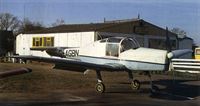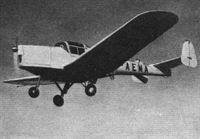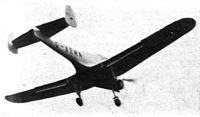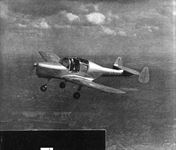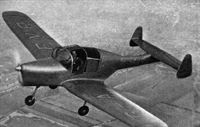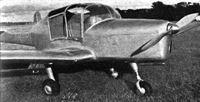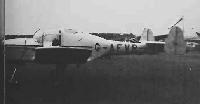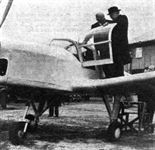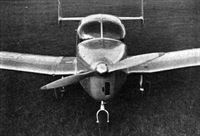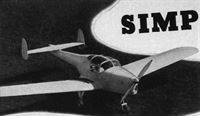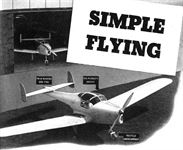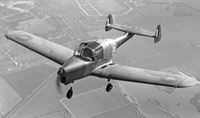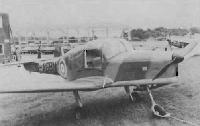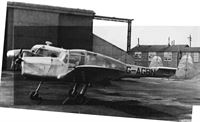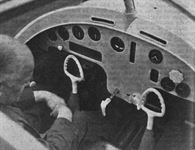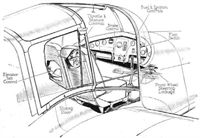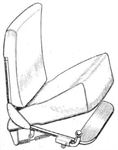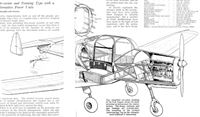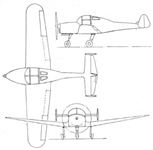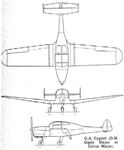
Описание
Страна : Великобритания
Год : 1939
Двухместный учебный и спортивный самолет
Варианты
- C.W. Aircraft - Cygnet - 1937 - Великобритания
- General Aircraft - Cygnet II / GAL.42 - 1939 - Великобритания
- General Aircraft - Owlet / GAL.45 - 1940 - Великобритания
General Aircraft G.A.L.42 Cygnet II
Права на легкий двухместный моноплан Cygnet после разорения в 1938 году компании "C.W. Aircraft" ("Chronander и Waddington Aircraft") приобрела "General Aircraft". Низкоплан с неубираемым шасси с хвостовой опорой, Cygnet стал первым британским легким самолетом цельнометаллической конструкции с работающей обшивкой. General Aircraft G.A.L.42 Cygnet II представлял собой доработанный прототип Cygnet с двухкилевым оперением и установленным позже трехопорным неубираемым шасси с носовой опорой. Серийное производство Cygnet II началось в 1939 году, но планы массовой постройки были сорваны с началом Второй мировой войны. Всего собрали лишь порядка десяти машин, пять из которых поступили в британские ВВС, где использовались для ознакомления летчиков с особенностями поведения самолетов с носовыми опорами шасси на режимах взлета и посадки.
ТАКТИКО-ТЕХНИЧЕСКИЕ ХАРАКТЕРИСТИКИ
General Aircraft G.A.L.42 Cygnet II
Тип: двухместный учебный и спортивный самолет
Силовая установка: один рядный ПД Blackburn Cirrus Major II мощностью 150 л. с. (112 кВт)
Летные характеристики: максимальная скорость на оптимальной высоте 217 км/ч; крейсерская скорость на оптимальной высоте 185 км/ч; начальная скороподъемность 244 м/мин; практический потолок 4265 м; дальность полета 716 км
Масса: пустого 669 кг; максимальная взлетная 998 кг
Размеры: размах крыла 10,52 м; длина 7,09 м; высота 2,13 м; площадь крыла 16,63 м2
Описание:
- General Aircraft G.A.L.42 Cygnet II
- Flight, July 1939
THE NEW CYGNET - Flight, September 1939
To-day's Light Aeroplanes - Flight, November 1939
Britain's Civil Aircraft
Фотографии
-
Aeroplane Monthly 1977-08 / G.A.L.42 Cygnet /Preservation Profile/ (52)
Регистрационный номер: G-AGBN [11], ES915 [11] -
Aeroplane Monthly 1994-04 / 1994 UK Aircraft Collections and Museums Guide
Регистрационный номер: G-AGBN [11], ES915 [11] Cygnet G-AGBN, seen at Strathallan in 1976, is now on static display at East Fortune.
-
Aeroplane Monthly 2000-04 / 2000 Airshows & Museums Guide
Регистрационный номер: G-AGBN [11], ES915 [11] Exhibited at the Museum of Flight in wartime camouflage, General Aircraft Cygnet G-AGBN is seen here at Biggin Hill in May 1975.
-
Aviation Historian 40 / R.Lezon - From West London to South America
Регистрационный номер: LV-FAH [2] The Cygnet remains in one piece, mounted on a pair of concrete stanchions at the Aeroclub Colon, northwest of the capital. The registration LV-FAH was cancelled in November 1996. One other Cygnet II went to South America, G-AGAW (c/n 112) becoming PP-TDY in Brazil in March 1941, the registration being cancelled in 1950.
-
Aeroplane Monthly 1990-08 / Personal album. Civil
Регистрационный номер: G-AGAX General Aircraft GAL 42 Cygnet G-AGAX flying from Fairoaks on January 15, 1949. First registered in November 1944 and flown in camouflage as a company communications hack, 'AX was owned by R. C. Cox when this photograph was taken.
-
Flight 1940-12 / Flight
Регистрационный номер: G-AEMA [4] The Cygnet (Cirrus Major) has recently been exported to Brazil, where it has created a very favourable impression.
-
Flight 1939-02 / Flight
Регистрационный номер: G-AEMA [4] STRANGE BUT LOGICAL: The G.A. Cygnet in its latest form, with twin rudders and tricycle undercarriage. In due time, of course, the forward leg will be faired; this wheel is steerable, but it may be locked in a fore-and-aft line if required.
-
Aeroplane Monthly 1993-05 / C.Prower - From Brisfit to Beverley (2)
Регистрационный номер: G-AEMA [4] The design of the side-by-side two-seater CW Cygnet was sold to General Aircraft, who further modified the aircraft, fitting it with twin fins and rudders and later adding a tricycle undercarriage in early 1939.
-
Flight 1939-05 / Flight
Регистрационный номер: G-AEMA [4] Mr. Hollis Williams' exposition of the tricycle Cygnet’s possibilities was one of the high spots of the afternoon.
-
Flight 1939-11 / Flight
One of the most efficient and practical light aircraft in the world - the G.A. Cygnet.
-
Flight 1939-09 / Flight Advertisements
Регистрационный номер: G-AFVR [8], HL539 [8] -
Flight 1939-09 / Flight
Регистрационный номер: G-AFVR [8], HL539 [8] The G.A. Cygnet in its production form. Notice the way in which the roof-"half" slides back.
-
Flight 1939-07 / Flight
Регистрационный номер: G-AFVR [8], HL539 [8] A three-quarter view of the Cygnet with one door slid back on its runners. The tricycle undercarriage is now fully cantilever. A Cirrus Major engine is fitted to the first production machine which is shown here.
-
Flight 1940-02 / Flight
Регистрационный номер: G-AFVR [8], HL539 [8] The Cygnet landing gear has been changed by the General Aircraft designers from the tailwheel design to this fixed nosewheel type.
-
Flight 1939-07 / Flight
Регистрационный номер: G-AFVR [8], HL539 [8] In this view of the production Cygnet the way in which the deeper cabin fairs into the monocoque fuselage is clearly shown, with one of the two split flaps.
-
Air-Britain Archive 1981-04
Регистрационный номер: G-AFVR [8], HL539 [8] G-AFVR Cygnet II which received its C of A on July 5th 1939 and survived until written off on August 26th 1969. Photograph by Bernard Martin at Booker on 21.5.66.
-
Air-Britain Archive 1986-01
Регистрационный номер: G-AFVR [8], HL539 [8] Cygnet G-AFVR became HL539 in November 1941 and was restored to the register in February 1946. It was sold to T.F.W.Gunton in April 1949 and remained with the same owner until written-off 20 years later. It was photographed while visiting the Isle of Man at Jurby on 29.5.65 by Terry Sykes.
-
Jane's All the World Aircraft 1980 / Encyclopedia of Aviation - Aircraft A-Z - v3
Регистрационный номер: G-AFVR [8], HL539 [8] General Aircraft Cygnet II.
-
Flight 1939-05 / Flight
THE AIR MINISTER LOOKS IN: Sir Kingsley Wood interested in the “tricycle” Cygnet during his visit last week to the Hanworth works of General Aircraft, Ltd.; Mr. E. C. Gordon England is showing him its features. “If I had to describe this Company, I should say that it was an enterprising Company,” said Sir Kingsley. Remembering the Cygnet, the pressure-cabin experiments and the firm's extensive rearmament work, the Air Minister’s compliment is deserved.
-
Flight 1939-07 / Flight
A front view of the production Cygnet showing the good ground range of vision through the moulded screen and the increased depth of the cabin.
-
Flight 1939-05 / Flight Advertisements
Remember your training days ... the difficulties you experienced. Judging a 3-point landing. Checking and holding off till the precise landing speed was reached. Taxying with your view obscured by the engine cowling, and trying to maintain your direction using coarse rudder. These difficulties do not exist with the Cygnet. Landing is simply a matter of gliding on to the wheels. As soon as one touches down, the aeroplane drops into a stable position on all three - and cannot bounce or fly off. Taxying is as easy as motoring, you can see directly ahead. Direction is self-maintained by twin rudders and fins, enabling the Cygnet to be flown 'feet off' at any throttle opening.
-
Aviation Historian 40 / R.Lezon - From West London to South America
Регистрационный номер: G-AGAS [2], LV-KGA [2] Put on to the British register in September 1940 as G-AGAS, Cygnet II c/n 117 was used for publicity photos - this one emphasising the type’s viceless characteristics by showing that even a lady could fly it (!) - before being dismantled and crated for transport by ship to Buenos Aires in Argentina, where it was registered LV-KGA.
-
Мировая Авиация 139
Регистрационный номер: G-AGBN [11], ES915 [11] Схожий внешне с Miles Messenger (имел третий, центральный, киль) Cygnet II ограниченно использовался в британских ВВС.
Airborne at Strathallan, 1976 -
Aviation Historian 20 / N.Stroud - Fire in the belly
Регистрационный номер: G-AGBN [11], ES915 [11] One of the aircraft considered for the fitting of a Whittle jet powerplant was the General Aircraft Ltd Cygnet II two-seat light tourer, powered by a 150 h.p. Blackburn Cirrus Major and fitted with an unusual tricycle undercarriage. This example, G-AGBN, was impressed into RAF service in July 1941 and given the serial ES915.
-
Air Pictorial 1977-05 / T.Norman - Strathallan Collection
Регистрационный номер: G-AGBN [11], ES915 [11] General Aircraft Cygnet G-AGBN/ES915 with the new hangar behind
-
Aeroplane Monthly 1977-08 / G.A.L.42 Cygnet /Preservation Profile/ (52)
Регистрационный номер: G-AGBN [11], ES915 [11] At the National Air Touring Competition, Cranfield, August 14, 1954
-
Aeroplane Monthly 1977-08 / G.A.L.42 Cygnet /Preservation Profile/ (52)
Регистрационный номер: G-AGBN [11], ES915 [11] GAL Cygnet II G-AGBN at Newcastle/Woolsington, 1949
-
Air-Britain Archive 1986-02
Регистрационный номер: G-AGBN [11], ES915 [11] General Aircraft Cygnet G-AGBN at Croydon in the late 1950s
GAL 42 Cygnet 2 G-AGBN seen at Biggin Hill in the 1960s. As ES915 it served in 1941 with No.23 Squadron who were operating Bostons and found a tricycle trainer useful. It later served with Cunliffe Owen at Eastleigh and in peacetime was restored by them to the civil register. -
Aeroplane Monthly 1990-04 / 1990 UK Aircraft Collections and Museums Guide
Регистрационный номер: G-AGBN [11], ES915 [11] The Museum of Flight’s GAL Cygnet G-AGBN at Biggin Hill in 1966.
-
Aeroplane Monthly 1977-08 / G.A.L.42 Cygnet /Preservation Profile/ (52)
Регистрационный номер: G-AGBN [11], ES915 [11] Unpainted and highly polished. Biggin Hill 1966
-
Aviation Historian 40 / R.Lezon - From West London to South America
Регистрационный номер: LV-KGA [2], G-AGAS [2] A poor-quality but extremely rare photograph of LV-KGA after its arrival in Argentina, possibly at one of the Tierra del Fuego airfields from which it operated during the war. It was used by members of the Fellowship of the Bellows, a wartime fundraising organisation in Latin America which helped purchase aircraft for the RAF.
-
Flight 1940-11 / Flight
CYGNETS IN BRAZIL. Prospects of orders are good since General Aircraft sent a Cygnet to Brazil, where it has created an excellent impression. South Americans are particularly pleased to find that, in spite of the war, England can still export aircraft. The colour scheme is light blue and cream. In the seat is Mr. E. C. Gordon England, managing director of General Aircraft.
-
Flight 1939-07 / Flight
The cabin layout, showing the wide entry on each side with the new sliding doors. These can be left in any position while flying - making the machine, if preferred, into an “open-air” type in hot weather.
-
Flight 1939-07 / Flight
When not in use, the seat cushions tip up so that there is no need to put muddy feet on them when entering the machine. Both seats have a sliding adjustment.
-
Aviation Historian 40 / R.Lezon - From West London to South America
Регистрационный номер: LV-FAH [2] Crunch! The Cygnet was extensively damaged during a landing accident, presumably at one of its Tierra del Fuego airfields, in March 1943. Given the difficulty of acquiring spare parts during the war it was then put into storage until 1947, when it was restored to airworthy status and re-registered as LV-FAH, as which it flew until 1963.
-
Flight 1939-07 / Flight
This simplified cut-away drawing of the G.A. Cygnet shows the basic structure at and around the centresection. The wings, tailplane and rear fuselage are stressed-skin. The mounting of the forward undercarriage leg on the strengthened bulkhead is interesting.
-
Flight 1939-09 / Flight
G. A. Cygnet (D.H. Gipsy Major).
- Фотографии


